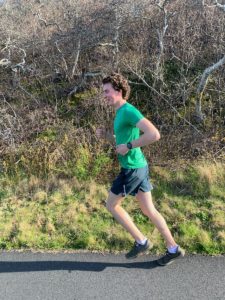PROVINCETOWN — When I arrived in Provincetown in January, I spent those first wind-chilled days learning the Independent’s proofreading software, reading up on interviewing techniques, and searching for running routes on iced-over roads.

The number of options in town disappointed me, but I quickly became familiar with the Province Lands bike trail, a curving five-and-a-half-mile route through the dunes.
Created by the National Seashore in 1967, the Province Lands trail is paved. Though full of cyclists now, during the winter it was, most of the time, my own. I logged hundreds of miles in the stillness there.
Coming from the East End on Commercial Street, I’d take a right on Arch Street to Conwell. After crossing Rt. 6, that street becomes Race Point Road. After half a mile, at the Beech Forest parking lot, the Province Lands trail begins on the right. I’d pass the visitor center and cross Race Point Road, then decide whether to turn left and continue back to the parking lot or head right to Herring Cove Beach, then south to the West End.
Some runners here guard the details of their favorite trails. My friend Alex Sharp, who was an Independent journalism fellow before me, has spent many summers running in Wellfleet, where his grandmother lives. He refuses to reveal his routes for fear of overcrowding. But he tells me about the seasonal shift that happens there.
“In the summer, when you run on Wellfleet trails, it’s really like you’re running in isolated woods,” Sharp says. But by late fall, “the trees are so bare you can see straight through to roads and houses.”
I’m preparing to leave the Outer Cape for a summer job on a whitewater rafting crew in Western Mass. and then college. A walk into Provincetown’s dunes with Mark Adams, the artist and former cartographer for the National Park Service, was one of the items on my predeparture list.
Pointing to low-growing plants on the sand, Adams tells me how reindeer lichen and Hudsonia stabilize the dunes and allow the ubiquitous pitch pines to grow. Adams says Provincetown foresters began planting Scots pine and black pine in the 1890s. The pitch pines, distinguished by needles in bundles of three, are slightly younger residents, having arrived here 80 to 100 years ago, he estimates.
They haven’t aged gracefully. The salty air and freezing winds have prevented taller growth, resulting in gnarly trees.
Krummholz, Adams says, meaning “knee timber,” is a German term used to describe these trees, with their stunted growth. In the dunes, these wind-pruned trees often grow in pairs or with twisting trunks. Adams thinks they may do that to protect one another.
During my runs, I always stuck to the paved trail and felt guilty when I had to use a desire path (an unmarked trail created by consistent human use) to avoid puddles or snowbanks. This time, however, I soon turned off the trail, following Adams into the dunes.
As part of the National Seashore, the dunes are open to the public, Adams explained, and walkers are encouraged to explore them — while disrupting the land and its life forms as little as possible.
“You have to develop your own ethic,” he says. On his dune walks, Adams says, he is “constantly faced with the decision of where to put each footstep.”
The dunes, completely outside the built environment, opened new paths to me. But they create challenges for a runner. It is difficult, even dangerous, to run in sand, as the ground gives way easily. Saltation — the movement of sand — causes deflation planes and blowouts, cut and carved by the wind, Adams says.
And the dune landscape is inhospitable to long runs, as it changes quickly from sand to small bogs, formed in the valleys between dunes.
Stopping in one bog, Adams turned over a leaf to reveal cranberries. I tasted one, suppressing my skepticism about consuming small red berries in the woods.
Keen on speed and distance, I likely didn’t take enough time to walk the dunes during my months in Provincetown. The sand forces a slower pace, good for recovery — or simply reflection.
But running in town and on the Park’s paved trail had its rewards.
Once, running in the West End, I passed two older men sitting on a bench outside the Coast Guard station. A younger man in a large SUV pulled out of a side street, rolled down his window, and asked, “Which way does this street go?”
“It’s one way,” one responded, “and it’s my way.”
Another time, on the Province Lands trail, I rounded a corner and came nearly foot to face with a fox, a small rabbit in its mouth. Foxes are attracted to Provincetown’s food scraps and rodents, easy prey. This canine, chasing something wilder, had ventured onto the paved path, as if to show me what lay beyond the asphalt.
Stillness replacing fear, we both paused, eyeing each other with what I hoped was mutual respect.
Then he turned away. And I ran on.



